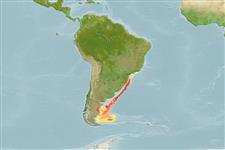Common names from other countries
Elasmobranchii (tubarões e raias) (sharks and rays) >
Squatiniformes (Angel sharks) >
Squatinidae (Angel sharks)
Etymology: Squatina: Latin for skate, which angel sharks superficially resemble, presumably tautonymous with Squalus squatina Linnaeus 1758 (no species mentioned). (See ETYFish); argentina: Presumably named for Argentina, described from off the coast of Buenos Aires (the province, not the city). (See ETYFish).
Environment: milieu / climate zone / depth range / distribution range
Ecologia
marinhas demersal; intervalo de profundidade 100 - 400 m (Ref. 57911). Subtropical; 19°S - 53°S, 68°W - 38°W (Ref. 54901)
Southwest Atlantic: Brazil to southern Uruguay.
Tamanho / Peso / Idade
Maturity: Lm ? range ? - 120 cm
Max length : 170 cm TL macho/indeterminado; (Ref. 247); common length : 100.0 cm TL macho/indeterminado; (Ref. 6077)
Descrição breve
Chaves de identificação | Morfologia | Morfometria
This species is distinguished from its congeners by having a darker background color, ranging from dark-brown to reddish-brown (vs. light-brown to dark-brown in S. guggenheim and S. occulta), with higher number of tooth rows with 24 vertical tooth rows in both upper and lower jaws, tooth formula 12-12/12-12; (vs. 9-9 to 10-10/9-9 to 11-11 in S. occulta, and 9-9 to 11-11/9-9 to 11-11 in S. guggenheim), and with anterior half of pectoral fin margin convex (vs. anterior margin of pectoral fin straight); differs from S. guggenheim and S. occulta with the interspiracular surface covered by small and homogeneous dorsal denticles, without enlarged denticles (vs. a pair of enlarged, conical and morphologically distinct dermal denticles between spiracles in S. occulta and S. guggenheim); differs from S. occulta by lacking blackish irregular small spots surrounding white spots on dorsal surface (i.e. absence of ocelli-like markings); differs further from S. guggenheim by having the dorsal midline denticles on trunk morphologically similar to other trunk denticles and barely organized in a row (vs. dorsal midline row of enlarged denticles morphologically distinct from other trunk denticles), the denticles close to origin of pectoral fin morphologically homogeneous, similar to other pectoral denticles (vs. presence of a pair, or more, enlarged and morphologically distinct denticles from other pectoral denticles, in S. guggenheim) (Ref. 95520).
Found on the continental shelf and slope. Ovoviviparous (Ref. 50449).
Life cycle and mating behavior
Maturities | Reprodução | Spawnings | Egg(s) | Fecundities | Larvas
Ovoviviparous, embryos feed solely on yolk (Ref. 50449). Both ovaries are functional (Ref. 57911).
Vaz, D.F.B. and M.R. De Carvalho, 2013. Morphological and taxonomic revision of species of Squatina from the Southwestern Atlantic Ocean (Chondrichthyes: Squatiniformes: Squatinidae). Zootaxa 3695(1):001-081. (Ref. 95520)
Categoria na Lista Vermelha da IUCN (Ref. 130435)
CITES (Ref. 128078)
Not Evaluated
Ameaça para o homem
Traumatogenic
Utilização humana
Pescarias: pescarias de subsistência
Ferramentas
Relatórios especiais
Descarregue XML
Fontes da internet
Estimates based on models
Preferred temperature (Ref.
115969): 4 - 16.3, mean 6.1 (based on 18 cells).
Phylogenetic diversity index (Ref.
82804): PD
50 = 0.5000 [Uniqueness, from 0.5 = low to 2.0 = high].
Bayesian length-weight: a=0.00676 (0.00293 - 0.01558), b=3.07 (2.88 - 3.26), in cm Total Length, based on LWR estimates for this Genus-body shape (Ref.
93245).
Nível Trófico (Ref.
69278): 4.1 ±0.6 se; based on diet studies.
Resiliência (Ref.
120179): Muito baixo, tempo mínimo de duplicação da população maior que 14 anos (Fec 7-11).
Fishing Vulnerability (Ref.
59153): Very high vulnerability (90 of 100).
Climate Vulnerability (Ref.
125649): High to very high vulnerability (71 of 100).
